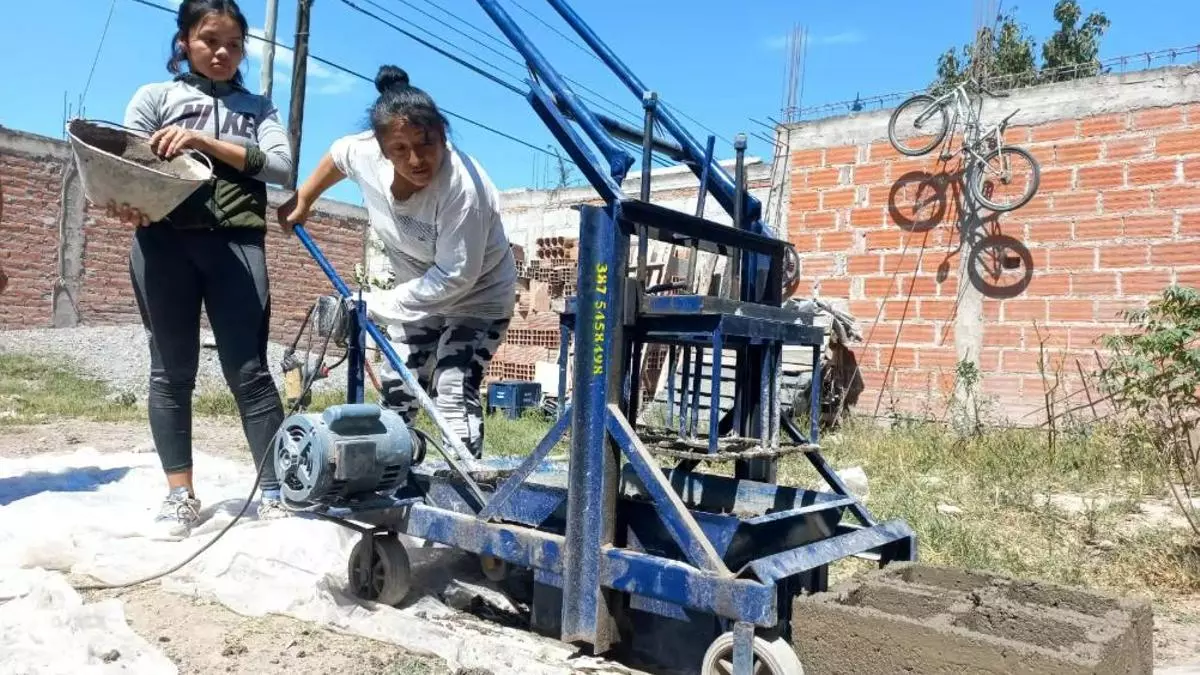In Salta, Argentina, more and more women are making their way into construction jobs, thanks to training programs and labor quota laws. They are breaking stereotypes, gaining economic autonomy, and demonstrating that in a historically male-dominated profession, strength can also be replaced with ingenuity and knowledge. Journalist Eva Marabotto tells the story of this program with a grant from the Latin American Solutions Journalism Fund, an initiative of El Colectivo 506, with the support of the Solutions Journalism Network and the Hewlett Foundation. This work was published by elDiarioAR on May 15, 2025, and was translated and adapted here for co-publication. Please note that the translation has been edited and adjusted for regional context.

“When you’re laying the lines to bring electricity to the neighborhood, the first thing is to put up the pillars, which are very heavy. To lift one of those and set it upright, you need four strong men—or six women. Or two women and a cart with a lever.”
For Natalia Ramos, the equation is that simple.
“Women replace strength with intelligence,” she explains.
But it wasn’t always like this. Although she was born in La Plata, Natalia has lived in the city of Salta for many years. There, she attended a technical school for secondary school and began a tertiary education program in biomedicine. However, during her hospital internships, the people around her tended to expect her to sit at a desk or clean.
Those people were not an isolated case. In Argentina, many men and women still believe that there are certain jobs for men, and others for women. This is even more true in Salta, more than 1,400 kilometers from Buenos Aires, where colonial architecture is preserved and worship of traditional patron saints is still a primary town activity.
Statistics translate these differences into numbers. In 2023—according to the Gender Indicators of the Argentine Labor Market, prepared by the Ministry of Economy through the Secretariat for Production Coordination and CEP XXI-Center for Production Studies—the feminization rate, meaning the percentage of women working in Salta, was 26.9%. In Buenos Aires, Argentina’s capital city, it was 40%.
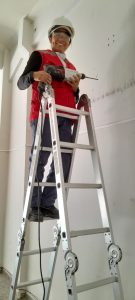
But other figures from the National Institute of Statistics and Census show that even in 2025, the average labor market insertion gap is 21% between men and women nationwide. Among those who are employed, men’s salaries are 29% higher than women’s. This difference worsens when the variable for unskilled workers, such as construction, is broken down, reaching a 35.7% difference in income between men and women.
First, the training
With these discrepancies in mind, in 2022, the provincial government in Salta decided to support women’s labor integration with vocational training courses. This began with the creation of the Secretariat for Women, Gender, and Diversity under the provincial Ministry of Government, Human Rights, and Labor. The program, called “Constructoras” (Builders), aims to train women and women and other traditionally excluded groups to join the sector.
The program’s choice to focus on the construction sector is not a random one. It is one of the temporary employment sectors that predominantly employs men. For women, the most precarious and temporary jobs are linked to domestic work or caregiving. However, the wage gap between the construction and domestic service sectors places women in a position of greater vulnerability and lower pay than men. In March 2025, the domestic service wage was between 2,863 Argentine pesos (about US$2.52) and 3,454 (about $3.04) per hour. In contrast, in the same month, construction wages started at US$3.04 and could reach $7.14 per hour, depending on the geographic area and specialization. These figures explain the interest in recruiting women to a better-paid occupation.
That’s why the province launched Constructoras, which began in mid-2022. The program is currently underway in Capital, Tartagal, Cafayate, Metán, Cerrillos, Galpón, Cachi, El Carril, Apolinario Saravia, La Caldera, Coronel Moldes, Angastaco, and Colonia Santa Rosa, thanks to collaboration with the Municipal Departments of Women, Gender, and Diversity in each of the municipalities. The latest municipalities to join during 2025 were San Carlos and the Puna region of Salta.
All courses are taught in collaboration with UPATECO (the Provincial University of Administration, Technology, and Trades).
“It’s a way to train them in a historically masculinized profession as a way to break down the barriers that still exist in some professions for women and LGBTQ+ people,” says Itatí Carrique, Secretary of Women, Gender, and Diversity under the Ministry of Government, Human Rights, and Labor in the province. “Furthermore, it means including them in a labor market that has better salaries than many other areas of the economy where women thrive, such as domestic workers.”
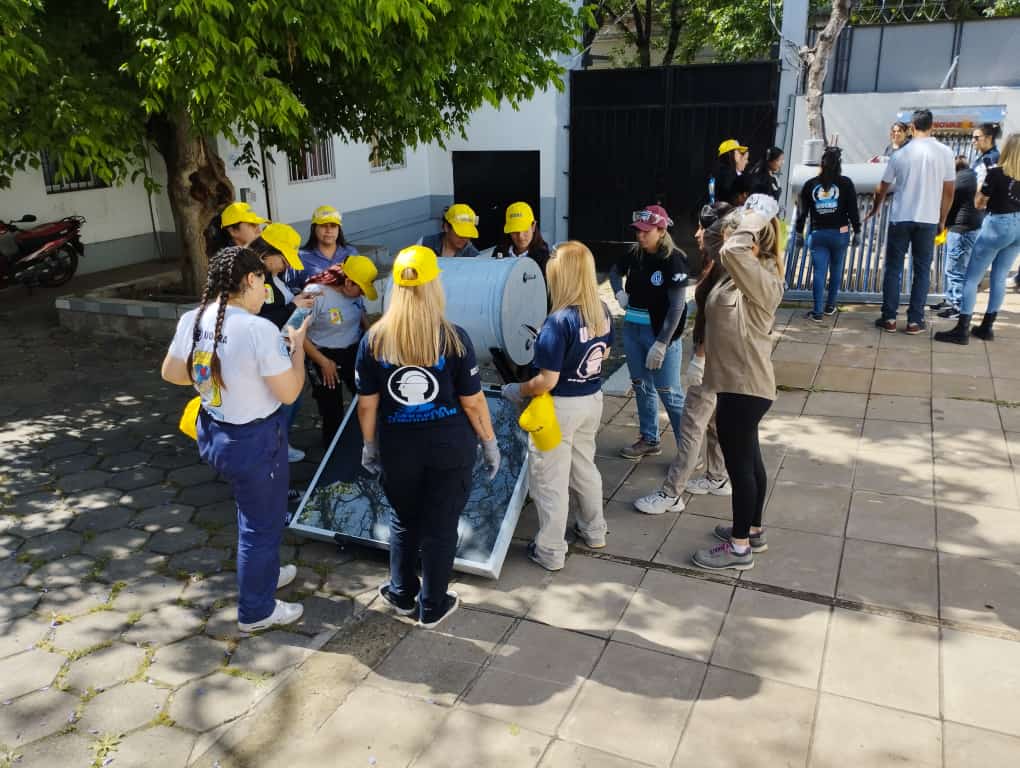
For Carrique, being able to include women in a labor market that offers better salaries and better conditions than the one they typically experience “allows women to have greater economic autonomy and greater opportunities to support themselves, which is one of the greatest challenges women face.”
These courses had a concrete effect: they trained the graduates, who learned trades and certified their knowledge to enter the construction industry. But there was another side effect. In 2023, Argentina’s Ministry of Public Works, alongside the Ministry of Women, Gender, and Diversity, announced the implementation of the Constructoras Program nationwide—building on the experience of Salta and other provinces with similar initiatives, such as La Rioja, San Luis, Catamarca, and Chaco. Since then, courses have begun to be developed throughout the country.
Although there is no disaggregated data by province, the inclusion of women in the construction sector has national estimates. In 2007, women made up 4.1% of workers, according to data from the CEP XXI. By 2023 (the last year recorded by the study), this figure had risen to 7.1%.
There’s an additional factor that helps explain the incipient growth that occurred during this period, in addition to the Salta program. During the same period, union representatives made a decision to begin similar training programs. This decision came from within the sector’s main union, the UOCRA (Union of Construction Workers). Through its UOCRA MUJER branch, it organized training workshops on gender equality for both men and women.
“Strengthening and making women visible in the sector helps more women join and become motivated,” explains Paula Martínez, head of the women’s union.
As a union members, she is aware of the differences in representation within the sector: “The construction industry is a masculinized industry, meaning that for a long time it was composed exclusively of men, and even today they are clearly the majority.” However, she points out: “This does not necessarily mean that it is a sexist industry. Construction can be as sexist, or as non-sexist, as the rest of society.”
Martínez admits that for a long time, the argument of physical strength was used as a reason to exclude women from participating in construction. However, echoing the anecdote told by Natalia Ramos, the union leader asserts that current technological advances make this reasoning outdated.
“It forces us to review what other preconceptions, what other mandates of masculinity and femininity are operating to keep it a heavily masculinized industry,” she adds.
While the current iteration of UOCRA Mujeres’s programming is more recent, the union’s concern for gender equality began in the early 2000s.
“Two milestones mark UOCRA Mujeres’ first actions: on the one hand, the passage of Law 25.674 on Female Participation in Collective Bargaining Units for Working Conditions, known as the ‘Women’s Union Quota Law’ in 2002,” says Martínez. “On the other hand, the 2001 crisis meant that many women, mostly heads of households, turned to the construction industry in their quest to make a living.”
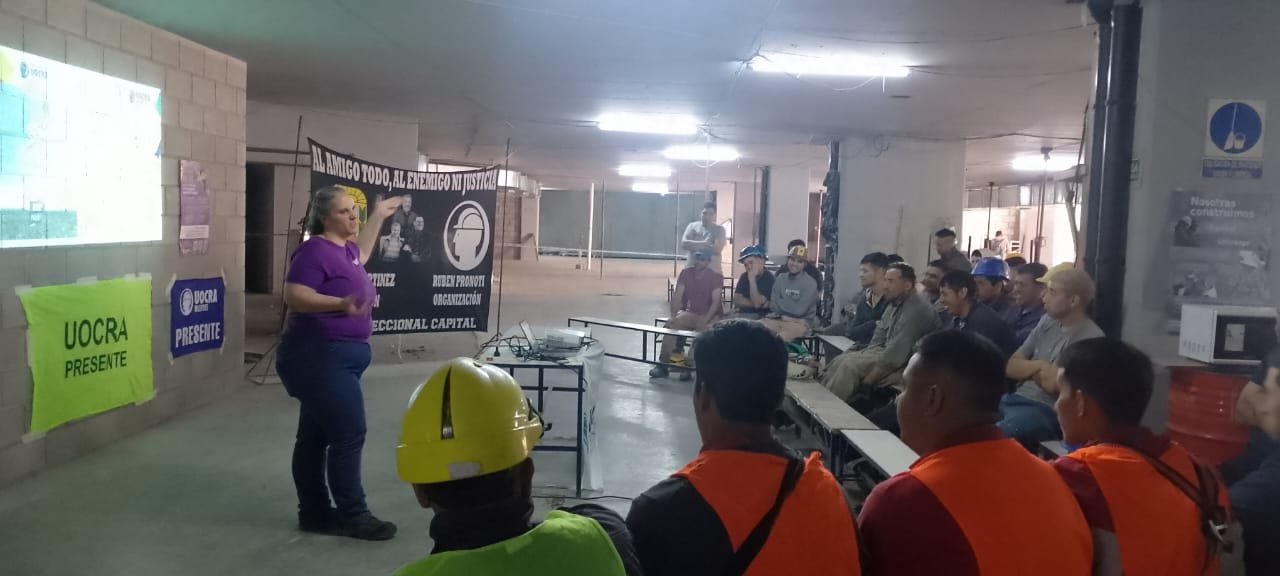
She explains that the creation of the union’s Women’s Department sought to address these two realities. It began its activities with surveys of women’s participation in large-scale construction projects. From there, it started addressing women’s health and safety in the construction industry and gradually added activities and responsibilities, including gender mainstreaming and awareness-raising. Throughout, the goal was to improve the quality of life of female construction workers and their families.
The union also found a way to bridge the gap through training.
“In 2023, with the UOCRA Foundation and the ILO’s PAGE Program, we held courses in which more than 120 women from different branches in Buenos Aires, Buenos Aires Province, and Mar del Plata participated,” she says. “In addition, in the Northern Zone branch (in Salta), 10 colleagues received training in electricity at the specific request of a company that later hired some of them.”
The training courses are taught by technicians and professionals from the Uocra Foundation, but there are also gender-based awareness-raising components, specifically involving Uocra Mujer.
“We are social science professionals and technical staff,” says Martínez. The team is federal and includes representatives from across the country from the Uocra Foundation, Uocra Mujer, and the union’s vocational training centers. They all designed the response together.
Funding also comes from various sources. “Some courses are funded by international organizations, others by local governments. Some were conducted in conjunction with the Argentine Chamber of Construction, and others were funded by the union. The program and funding were adapted to each situation,” she says.
Next, the quota
In the specific case of Salta, the impact of training was heightened by another factor: a political decision. Thanks to the awareness raised by the Constructoras program, 15 municipalities in the province of Salta have passed a gender quota law. The law requires that in order to win municipal public works concessions, companies must have at least 10% women among their workers.
“Since the province was training women through the Constructoras program, we sought a tool from the City Council to incorporate these qualified women into the workforce. We found it in the public works quota,” says Councilwoman Malvina Gareca from the city of Salta, which in November 2022 successfully passed a proposed amendment to incorporate Article 3 Bis into Regulation 15,593 (Adherence to the Provincial Contracting System) to establish the female quota. Months later, in May 2023, Councilwoman Alicia Vargas pushed for this 10% quota to be extended not only to contracts but also to projects carried out directly by the Salta municipality—and to the workers at the municipal concrete plant that produces materials for public works.
And now, the results
These programs provide women with training in construction-related trades. UOCRA Martinez reports that 120 women were enrolled in 2023, 27 in 2024, and another 27 in Comodoro Rivadavia, another district where a public works quota law was being promoted.
“UOCRA’s role as a union is to promote and facilitate these initiatives while also offering technical training to our colleagues so that when these jobs actually become available, they have the necessary skills to thrive in this industry,” Martínez says.
When it comes to the Constructoras program in the province of Salta, Carrique says that since mid-2022, the province has trained 1,100 women.
“In addition to training in the provincial capital, which represents the largest volume, we have also trained in 15 of the 60 provincial municipalities. This year, we are continuing with the training; in fact, we just delivered the latest certificates.”

While the initiative in Salta continues to develop, the national Constructoras program has developed only a few courses. The Ministry was dissolved in June 2024 [editor’s note: this was part of President Javier Milei’s aggressive rollback of a wide variety of initiatives, including those favoring gender equity] and the trainings were discontinued. The only remaining trace of them is a manual called “The gender perspective in the public works cycle.”
This publication, produced by the Ministry of Public Works in conjunction with UN Women, seeks to foster the inclusion of women in the workforce. The manual compiles best practices in the administrative and financial management of public works with a gender perspective in Argentina and other Latin American countries such as Peru, Bolivia, and Uruguay.
Salta’s Gender Secretary says that the Constructoras program continues to bring many concrete results to the province: “Some of these women were included in public works projects—including specific, emblematic cases such as the construction of the Cafayate Convention Center, or a housing project run by the Provincial Housing Institute.”
Gareca also assesses the experience as positive, based on the companies’ feedback: “They tell us that the women do an excellent job. They’re very responsible. They praise the quality of the finishes and that they’re very organized. Sometimes, more so than the men.”
“Knowledge gives us advantages,” says Ramos, one of the women who trained in the province. “At first, they sent us to clean or sit at a desk doing paperwork. But then they realized we were useful. We’re organized, and we make up for our strength with knowledge, tools, and ingenuity.”
In this regard, Ramos, one of the course beneficiaries, notes: “I’ve always been interested in trades; in fact, I studied at technical school. But I was also tempted by the pay, which is better than other occupations. And being able to organize my schedule.” She then explains that she chose to do electrical wiring for construction sites and other private jobs so she could have more time and balance it with caring for her two children.
Then there are the more personal rewards.
“My 10-year-old daughter is proud of me. When people ask her at school what her mom does, she tells me all the jobs I have, and that I also have crops and chickens at home,” says Verónica González, another Salta native who attended the classes.
“My husband found it strange when I first started going to work. He thought I’d be back right away. Now he’s used to it, and I have his 100% support. He picks up our daughter from school while I’m at work,” Ramos relates, referring to the daily changes in the family dynamic.
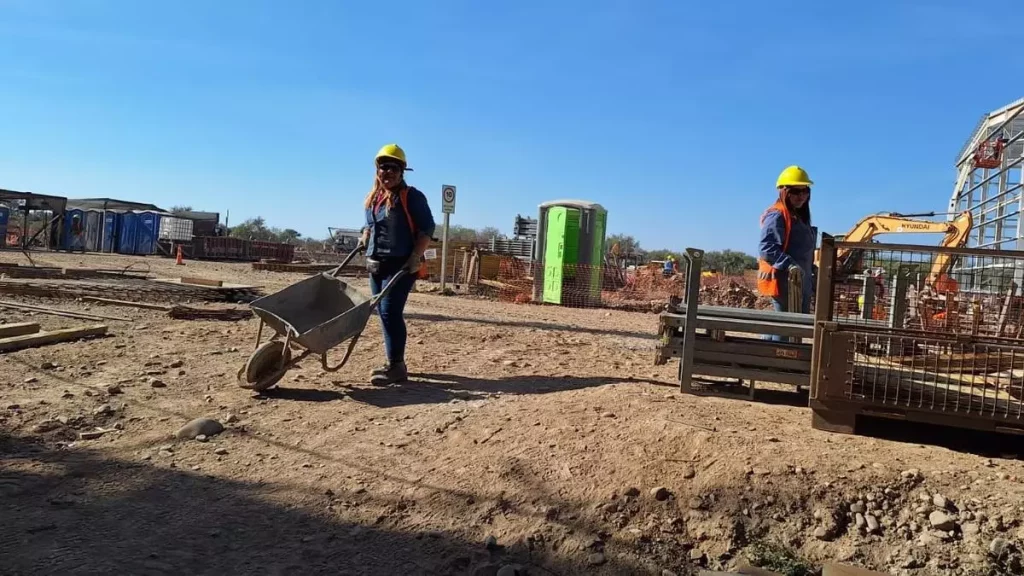
The revolution also took hold in the classroom.
“When I started the first masonry course, my classmates were surprised. I was the only woman among 18 men,” González explains. “In the neighborhood, they’re also surprised that I know about masonry, electricity, and even how to fix washing machines. They call me a jack-of-all-trades.
“When they hire me through WhatsApp to do a repair, they’re surprised that a woman shows up,” she says, amused.
Her colleague Natalia Ramos also describes her clients’ reaction: “They try to pay me less because I’m a woman. They tell me they’ll pay me whatever they want. It’s hard to gain respect.”
Following the disappearance of the Ministry of Women, local training increased because the national government no longer organizes courses. Paula Martínez, from UOCRA, notes: “I believe it is impossible to isolate the impact of the closure of state gender agencies—the Ministry of Women, Gender, and Diversity of the Nation, among them, but not exclusively—solely in terms of demand for training. There are many factors that could modify this demand: for example, the rising unemployment rate, which is leading many people to seek new livelihood alternatives, and see acquiring new skills as an opportunity.”
However, she explains: “The closure of state gender agencies implies the loss of the state interlocutor in tripartite dialogue (employer sector, labor sector, State), which means that various lines of joint work deteriorate or are lost.”
UOCRA was able to continue expanding its reach to local chapters across the country in 2024.
“We worked with 34 local chapters, 18 of them for the first time in 2024, which meant more than 1,200 colleagues participated in awareness-raising activities, either in person or virtually,” she summarizes.
Lessons learned
Those who went through training and entered the construction labor market still point to unfinished business. For example, it’s hard to shake the preconception surrounding women’s lack of knowledge of certain tasks traditionally considered masculine.
“When they hire a man, they don’t ask him where he learned, because they think it’s normal for him to know how to do certain tasks. Since I’m a woman, they ask me questions and don’t believe I know how to do them,” Ramos laments.
The first lesson learned about the integration of women in construction emerged along the way: to integrate them, it was necessary to try to eradicate stereotypes. This is how Martínez describes it: “At UOCRA Mujeres, we also work with companies that are willing to [help] remove the sociocultural patterns that limit women’s access to their rights, equality, and non-discrimination.”
Nancy Hornus, head of the Equity Program at the Argentine Chamber of Construction (Camarco), explains that, like the union branch, the business entity focused on awareness-raising. “At the Chamber, we joined in to support employers since the state had established a gender perspective in public works. We began working to raise awareness among employers. The goal was to unlearn the usual way of working in order to incorporate this perspective.”
The quota law implemented in Salta as a result of the training has inspired replicas in other parts of the country, and prompted cities like Concordia to approve a quota ordinance for public works. In Mar del Plata, it is still just a proposal. In Comodoro Rivadavia, it was passed in December 2024 with the requirement of a higher percentage: 15%female participation.
This possibility of replication was systematized in the manuals published by the Ministry of Public Works in 2023. Within this framework, also in October 2023, the Ministry of Public Works presented the Federal Network for Construction with a Gender Perspective, a policy coordinated with the Argentine Construction Workers’ Union (UOCRA) and the Argentine Chamber of Construction (CAMARCO) that seeks to consolidate and deepen the strategies deployed throughout the country to reverse the gender gaps that historically affect the sector by strengthening the participation of women and LGBTI+ people. However, following the start of the Milei administration in December 2023, these actions were deactivated.
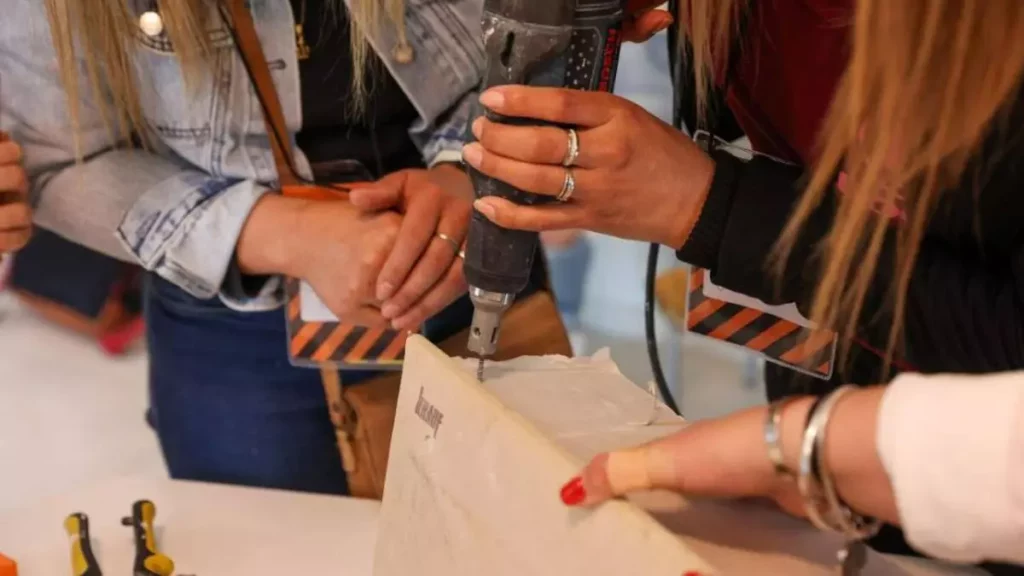
Women who have been trained say they have more suggestions.
“The course instructor was a man, and sometimes he called us muchachos or changos [editor’s note: an idiom used in northwestern Argentina to refer to a young man], and forgot that we were all women. I think they should take that into account,” explains Ramos, who, faced with this lack of knowledge, decided to become a trainer herself. “Now I train women to teach us and learn about ourselves. In fact, I’m going to the Puna region of Salta to teach a course.”
Participants say they realized they needed to manage their time to balance their new jobs with the household chores they usually face.
“More than working on a construction site, it helps me do specific jobs. That way I can keep up with my daughter’s activities—taking her to and from school, taekwondo, or English classes, and doing chores around the house,” saysGonzález, who even boasts of having gardens in the backyard. “Some of the girls who took the courses can’t manage their schedules and their families. Ultimately, what they learned was limited to helping them make improvements in their own homes.”
Aware of this need for many women to be workers and, at the same time, wives and mothers, and to combine household chores and caregiving, Councilwoman Gareca says that some municipalities promoted the creation of public works cooperatives where 50% of the employees are women. These cooperatives offer flexible schedules so workers can balance work and family.
Limitations
Most of the limitations are related to political decisions. Paula Martínez describes the situation this way: “The number of women and diverse workers in the construction industry remains small, although it showed sustained growth until the end of 2023. In 2024, with the elimination of the Ministry of Public Works and the near-elimination of public works themselves, the blow to the employment level of construction workers was extremely severe. It is estimated that 200,000 direct jobs were lost. Among them, of course, are jobs for women workers.”
With fewer women employed, there are logically fewer union dues and less funding available for courses and training.
The union leader emphasizes the role of the State as a guarantor of rights and as a regulator of relations between the employer sector and the worker sector. “Not only was the Ministry of Women, Gender, and Diversity of the Nation dissolved—ministries or gender areas in several provinces were also closed or demoted. Organizations in other ministries that mainstreamed the gender perspective in their respective areas of intervention were also closed. Therefore, there is a lack of interlocutors. All the progress that had been made in terms of the inclusion of women and diversity in construction is now in question.”
Lorena González, head of the General Directorate of Women and Diversity of the Municipality of Salta, explains that although the gender quota ordinance is still active, no progress has been made in regulating it to define its specific scope. This means that the integration of women still depends on the goodwill of companies; the law is a powerful tool that is underutilized. Many ordinances require explicit regulations that include the scope and method of implementation. This is not the case with the quota, which depends on the goodwill of companies.
From a day-to-day perspective, Natalia Ramos suggests adding practical lessons to the courses.
“Of course there are lessons, but based on my experience, there should be more of them, so the girls leave with more confidence and more practical knowledge,” she says. “We also sometimes lack equipment. The program gives you a financial incentive, and I took advantage of it to buy a drill, but the tools are expensive, and banks have a harder time granting loans to women than to men. So you can’t arm yourself with the tools you need to work on a construction site or do specific construction jobs.”
As a student and as a trainer, Ramos dreams of the possibility of every woman receiving a construction tool kit along with her training certificate.
In the meantime, she focuses on passing on what she knows, both in the classroom and within her own family.
“When I go to do a job, I sometimes take my children along with me. I give them the toolbox and ask them to pass it to me so they can learn,” she says. “Both the boy and the girl, because both can be builders.”


